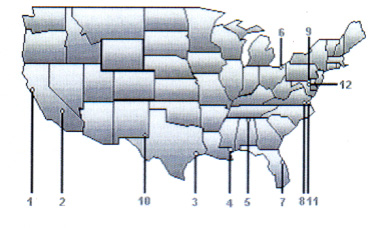Preface
P.1 PURPOSE
This NPR describes NASA's Environmental Management System (EMS). An EMS is a system that (1) incorporates people, procedures, and work practices in a formal structure to ensure that the important environmental impacts of the organization are identified and addressed, (2) promotes continual improvement by periodically evaluating environmental performance, (3) involves all members of the organization as appropriate, and (4) actively involves Senior Management in support of the environmental management program. The purpose of the Agency EMS is to have a single overall Agency approach to managing environmental activities that allows for efficient, prioritized program execution.
This NPR provides overall direction for both NASA-wide EMS documentation and Center-level documentation. NASA-wide documentation, NASA Policy Directive (NPD) and NASA Procedures and Guidelines (NPR), are the minimum EMS performance criteria. Center EMS implementation planning activities will add content to reflect Center-specific needs. This NPR supports the NASA Safety and Health Program, including risk management and loss-prevention priorities.
P.2 APPLICABILITY
The EMS scope includes the following NASA Centers and Component Facilities:
a. Ames Research Center.
b. Dryden Flight Research Center.
c. Glenn Research Center at Lewis Field.
d. Glenn Research Center, Plum Brook Station.
e. Goddard Space Flight Center.
f. Goddard Space Flight Center, Wallops Flight Facility.
g. Headquarters.
h. Johnson Space Center.
i. Johnson Space Center, White Sands Test Facility.
j. Kennedy Space Center.
k. Langley Research Center.
l. Marshall Space Flight Center.
m. Stennis Space Center.
NASA CENTERS

- Ames Research Center
- Dryden Flight Research Center
- Johnson Space Center
- Stennis Space Center
- Marshall Space Flight Research Center
- Glenn Research Center at Lewis Field/Glenn Research Center, Plum Brook Station
- Kennedy Space Center
- Langley Research Center
- Goddard Space Flight Research Center
- Johnson Space Center, White Sands Test Facility
- Goddard Space Flight Research Center, Wallops Flight Facility
- Headquarters
Component Facility Management shall be responsible for implementation of an EMS commensurate with the environmental responsibilities delegated by the Center Director. The Component Facility EMS may be separate from the Center EMS.
Management at each Center is responsible for determining the applicability of this EMS to its contractors. When a determination is made that the EMS is applicable, the Center management must assure that a requirement for implementing this EMS be incorporated into all such contracts no later than the time of recompetition of the contracts.
In the case of a NASA-owned, contractor-operated facility, NASA officials responsible for the contract shall incorporate a requirement for implementing an EMS, if determined appropriate, into the contract for operating the NASA-owned, contractor-operated facility no later than the time of recompetition of the contract. The requirement need not be for this EMS but shall require an EMS that satisfies the EMS-related requirements of Executive Order 13148 (and applicable Federal Acquisitions Regulations). If the contractor does not satisfy this requirement, then the NASA official has discretion whether to specify the conditions pursuant to which the contractor must choose and administer an EMS. Such conditions may include restrictions as to the type of EMS and provisions for Government control or supervision of the EMS desired by the Center management. The Office of Space Science at Headquarters shall make this determination with regard to the Jet Propulsion Laboratory.
P.3 AUTHORITY
a. NPD 8500.1, NASA Environmental Management.
b. Executive Order 13148, April 21, 2000, Greening the Government Through Leadership in Environmental Management, 3 CFR (2000 Compilation)
P.4 REFERENCES
a. 48 CFR Subpart 23.10, Federal Acquisition Regulation (FAR) Federal Compliance with Right-To-Know Laws and Pollution Prevention Requirements.
b. NPD 1440.6, NASA Records Management.
c. NPD 2800.1, Managing Information Technology.
d. NPR 1400.1C, NASA Directives System Procedures and Guidelines
e. NPR 1441.1C, Records Retention Schedules.
f. NPR 7120.5A, Program and Project Management Processes and Requirements.
g. NPR 8580.1, Implementing The National Environmental Policy Act and Executive Order 12114.
h. NPR 8621.1, NASA Procedures and Guidelines for Mishap Reporting, Investigating, and Recordkeeping.
i. NPR 8715.2, NASA Emergency Preparedness Plan Procedures and Guidelines.
j. NPR 8715.3, NASA Safety Manual.
k. NPR 8820.3, Pollution Prevention.
l. Code of Environmental Management Principles (CEMP): Environmental Protection Agency, October 16, 1996.
m. ISO 14001: International Organization for Standardization (ISO) for Environmental Management Systems, 1996.
P.5 CANCELLATION
None.
/s/ Jeffrey E. Sutton
Assistant Administrator for
Institutional and Corporate Management
![[NASA Logo]](../Images/nasaball.gif)
